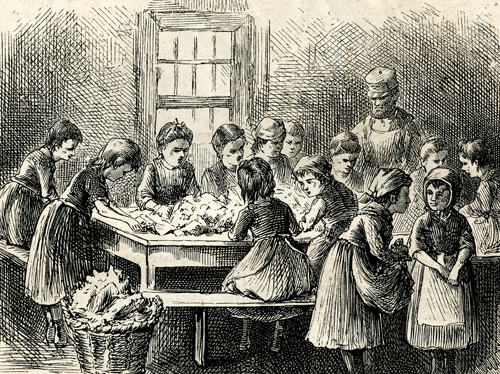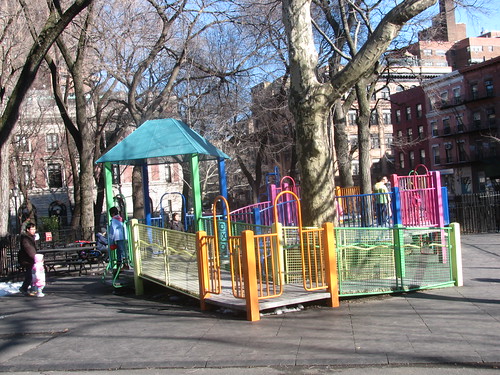A Natural History of Playgrounds
For some time now, I've been meaning to write something here about playgrounds, which are substantial components in the natural areas and parklands of most cities worldwide.
I was first inspired by Rebecca Mead's "State of Play" feature in a July issue of the New Yorker. That article is mostly about a new generation of "imagination playgrounds" that are beginning to appear in Manhattan, but Mead begins her article with a description of the rainy opening day at the Lower East Side's Seward Park Playground, the first ever municipally-built playground in the United States:
 Children stripping tobacco, from "The Little Laborers of New York City,"
Children stripping tobacco, from "The Little Laborers of New York City,"
Harper's New Monthly Magazine, August 1873.
Mayor Low was one of the first New York City mayors of the progressive era and an anti-Tammany Hall reformer. The playground he opened reflected a philosophy of social reform, that children "have a right to play," and that they needed opportunities to escape the crowded conditions of the tenements.
Seward Park had a lot of the ingredients we associate with playgrounds today: open fields, slides, monkey bars, swings, and sandboxes.
 Seward Park at the corner of E. Broadway, Canal, and Essex Streets in 1912. Image from the Library of Congress.
Seward Park at the corner of E. Broadway, Canal, and Essex Streets in 1912. Image from the Library of Congress.
In photographs, the playground equipment of 1903 looks incredibly dangerous to my modern eyes:
The height of those high monkey bars remind me that eugenics for the lower classes was also a progressive era fad that the playground's designers might, possibly, have had in mind. But that's probably just my paranoid perspective as someone who is both afraid of heights and living in a litigious society.
In addition to the play equipment, which was designed to encourage vigorous physical activity, the playground also had designated park employees who would lead children in athletic games, segregated by gender. In this 1908 photo from the Parks Department archives, a Seward Park employee leads a group of girls in something called a "Ten Pin Pursuit Race":
 So, in spite of the chaos of the opening day, the city's first playground was clearly designed and programmed to control the playing behavior of the lower-class neighborhood's kids, who had been overrunning the streets in rough reenactments of Spanish-American War battles, and playing in the filth of the city's vacant lots.
So, in spite of the chaos of the opening day, the city's first playground was clearly designed and programmed to control the playing behavior of the lower-class neighborhood's kids, who had been overrunning the streets in rough reenactments of Spanish-American War battles, and playing in the filth of the city's vacant lots.
This is a theme of playgrounds that continues to this day. Just last week, I attended a neighborhood meeting about a proposal to build fancy new basketball courts next to one of Portland's larger public housing complexes. The phrase "get kids off the streets" came up several times, even though, if the goal is to get troublemakers off the streets, some kind of playground for middle-aged alcoholics might be more useful.
Every park is the product of human values and physical interventions. Even our most remote, backcountry "wilderness" areas are shaped by hiking trails, fire policy, and the historical extirpation of native peoples by military force.
But playgrounds take the physical manifestation of our social values in the outdoors to the extreme. They're the section of a city park where nearly all plants have been removed and the soil itself has been replaced with a kind of soft, antiseptic ground cover (usually wood chips, or sometimes a kind of rubberized pavement). The way playgrounds are designed - how they dictate the terms of how children play - are a faithful reflection of a city's hopes and anxieties for the next generation.
A century later, Seward Park still exists in the Lower East Side, and there's a newly-renovated playground there. It is strikingly less vertical than the first one, and probably safer. But there is no mob of twenty thousand children, breaking down the fences, desperate to start playing.
I was first inspired by Rebecca Mead's "State of Play" feature in a July issue of the New Yorker. That article is mostly about a new generation of "imagination playgrounds" that are beginning to appear in Manhattan, but Mead begins her article with a description of the rainy opening day at the Lower East Side's Seward Park Playground, the first ever municipally-built playground in the United States:
"By 2 p.m., when the opening ceremony was scheduled to begin, twenty thousand children had swarmed the playground and its surrounding streets, climbing on rooftops and fire escapes for a better view of the seesaws, swings, and sandboxes... Eventually, the kids stormed the park gates, overwhelming two hundred police officers who were trying to keep order. 'They swept around and through the policemen, and, without pausing, leaped over the iron fence about the playground,' the Times reported the next day...Now that playgrounds have become a common feature in every city, town, and schoolyard in the nation, it's hard to imagine how the opening of one could inspire a riot of 20,000 children. But in 1903, when Seward Park opened, the Lower East Side was packed solid with poor immigrant families whose children worked from an early age.
Mayor Low did speak, although the noise of the crowd was such that only those in his immediate vicinity could hear what he had to say: 'The city has come to realize that it must provide for its children, that they have a right to play as well as to work.'"-Rebecca Mead, "State of Play"
 Children stripping tobacco, from "The Little Laborers of New York City,"
Children stripping tobacco, from "The Little Laborers of New York City,"Harper's New Monthly Magazine, August 1873.
Mayor Low was one of the first New York City mayors of the progressive era and an anti-Tammany Hall reformer. The playground he opened reflected a philosophy of social reform, that children "have a right to play," and that they needed opportunities to escape the crowded conditions of the tenements.
Seward Park had a lot of the ingredients we associate with playgrounds today: open fields, slides, monkey bars, swings, and sandboxes.
 Seward Park at the corner of E. Broadway, Canal, and Essex Streets in 1912. Image from the Library of Congress.
Seward Park at the corner of E. Broadway, Canal, and Essex Streets in 1912. Image from the Library of Congress.In photographs, the playground equipment of 1903 looks incredibly dangerous to my modern eyes:
The height of those high monkey bars remind me that eugenics for the lower classes was also a progressive era fad that the playground's designers might, possibly, have had in mind. But that's probably just my paranoid perspective as someone who is both afraid of heights and living in a litigious society.
In addition to the play equipment, which was designed to encourage vigorous physical activity, the playground also had designated park employees who would lead children in athletic games, segregated by gender. In this 1908 photo from the Parks Department archives, a Seward Park employee leads a group of girls in something called a "Ten Pin Pursuit Race":
 So, in spite of the chaos of the opening day, the city's first playground was clearly designed and programmed to control the playing behavior of the lower-class neighborhood's kids, who had been overrunning the streets in rough reenactments of Spanish-American War battles, and playing in the filth of the city's vacant lots.
So, in spite of the chaos of the opening day, the city's first playground was clearly designed and programmed to control the playing behavior of the lower-class neighborhood's kids, who had been overrunning the streets in rough reenactments of Spanish-American War battles, and playing in the filth of the city's vacant lots.This is a theme of playgrounds that continues to this day. Just last week, I attended a neighborhood meeting about a proposal to build fancy new basketball courts next to one of Portland's larger public housing complexes. The phrase "get kids off the streets" came up several times, even though, if the goal is to get troublemakers off the streets, some kind of playground for middle-aged alcoholics might be more useful.
Every park is the product of human values and physical interventions. Even our most remote, backcountry "wilderness" areas are shaped by hiking trails, fire policy, and the historical extirpation of native peoples by military force.
But playgrounds take the physical manifestation of our social values in the outdoors to the extreme. They're the section of a city park where nearly all plants have been removed and the soil itself has been replaced with a kind of soft, antiseptic ground cover (usually wood chips, or sometimes a kind of rubberized pavement). The way playgrounds are designed - how they dictate the terms of how children play - are a faithful reflection of a city's hopes and anxieties for the next generation.
A century later, Seward Park still exists in the Lower East Side, and there's a newly-renovated playground there. It is strikingly less vertical than the first one, and probably safer. But there is no mob of twenty thousand children, breaking down the fences, desperate to start playing.













